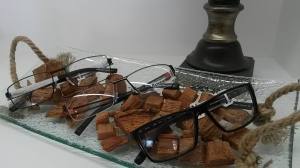 For many, many years glass lenses where very common and popular due to a natural resistance to scratches as well as a lack of any good alternative lens materials. Thankfully that has changed. The main downside to glass lenses is that they are, well…glass. Having glass break or shatter so near the eye from a flying rock or an unexpected tumble can lead to a truly dangerous and vision threatening situation. With better lens material alternatives available, glass lenses are very rarely used in today’s glasses market.
For many, many years glass lenses where very common and popular due to a natural resistance to scratches as well as a lack of any good alternative lens materials. Thankfully that has changed. The main downside to glass lenses is that they are, well…glass. Having glass break or shatter so near the eye from a flying rock or an unexpected tumble can lead to a truly dangerous and vision threatening situation. With better lens material alternatives available, glass lenses are very rarely used in today’s glasses market.
The most commonly used lens materials today are Plastic (or CR-39), Polycarbonate, High Index, and Trivex®. Let’s talk about the benefits and drawback to each and where each is particularly useful.
Plastic lens material, commonly known as CR-391
Plastic is the least expensive lens material, is very easy to machine, and has very good clarity to boot. Although commonly used, plastic is a less than ideal lens material because it is soft and prone to scratch very easily – some type of scratch coating on Plastic lenses is highly recommended. Plastic lenses are also not impact resistant and will break and crack easily if impacted – just like glass. Another downside is plastic lenses do not inherently block UV light and additional UV coating is needed. Finally, plastic is not a dense material and will add significant weight and thickness to a lens if you have a significant prescription.
Polycarbonate lens material, commonly known as simply “Poly”
Polycarbonate is a significant improvement in lens material to plastic lenses for several reasons2. Although only slightly more expensive than regular plastic, polycarbonate is far more impact resistant lens material and the added hardness of the lens makes it naturally scratch resistant. As a result, polycarbonate is a perfect lens material for children or even adults who are hard on their glasses. Also, the added density of polycarbonate lenses makes this lens 20-35% percent thinner and lighter than Plastic3 and thus a much better choice for patients with higher prescriptions or those that are concerned with lens weight and thickness. Finally, Polycarbonate is also naturally UV protective, blocking 100% of harmful UV light without an added UV coating needed. The main downside to Polycarbonate is that the optical quality, although very good, can cause some patients issues with distortions.
High Index Lenses4
High index lens material is essentially a higher density version of the polycarbonate lens. In addition to all the benefits of polycarbonate over plastic lenses, the higher density of High Index Lenses makes them the thinnest lens material option available for patients with higher prescriptions.
Trivex® lenses5
This lens material was first introduced in 2001 and are a relatively new name in the lens materials market. Trivex®, like polycarbonate, is similarly thin, light weight, impact resistant lens material with 100% UV protection. The main different between the two is in how the lenses are made. Polycarbonate lens are made of a thermoplastic material that starts out as pellets that are melted down and then injected into lens molds under very high pressure and then allowed to cool. Trivex® by contrast is a liquid polymer that is simply pumped into a lens mold and cured as opposed to the melting, pressure injection, and cooling of polycarbonate. This construction feature of Trivex® results in a lens that with less internal stress which produces sharper central vision and fewer distortions through the peripheral or outside parts of the lens6.
Precision Family Eye Care Recommendations on Lens Materials:
1. Avoid plastic lenses if possible, Trivex® and polycarbonate are safer, lighter weight and are naturally UV protective and scratch resistant.
2. If you have a higher prescription or are just concerned about lens weight or thickness, strongly consider upgrading to High Index lens material, they are thinnest and lightest lens material available.
3. Although fairly new, Trivex® is a tested and reliable lens material that has all the benefits of polycarbonate and with superior optics and fewer distortions.
References
1. http://en.wikipedia.org/wiki/CR-39
2. http://vision.about.com/od/eyeglasses/qt/Polycarbonate-Lenses.htm
3. http://www.ehow.com/info_8512878_advantages-disadvantages-cr39-lenses.html
4. http://www.allaboutvision.com/lenses/highindx.htm
5. http://www.ppg.com/optical/opticalproducts/opticalmaterials/Pages/Trivex.aspx
6. http://www.allaboutvision.com/lenses/polycarb.htm


